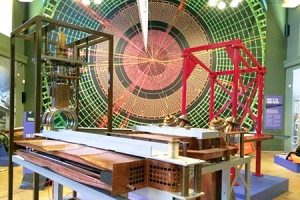Feb 12 2014
An exhibition celebrating University of Liverpool’s 120 years of particle physics has opened at the Victoria Gallery & Museum.
 The bubble chamber is one of many exhibits celebrating Liverpool’s rich history of particle physics
The bubble chamber is one of many exhibits celebrating Liverpool’s rich history of particle physics
`A World A Particle’ charts the contribution of the University of Liverpool to the field of Particle Physics – Past, Present and Future, from the 1890s through to the University’s current involvement in the world’s largest particle accelerator, the Large Hadron Collider at CERN.
Sir Oliver Lodge
Physics at the University began in 1894 when Sir Oliver Lodge used the clock tower of the Victoria Building (now the VG&M) to send the first radio signal as a morse code message to the tower of Lewis’s department store, at the bottom of Brownlow Hill.
From the ground-breaking work of Oliver Lodge and three Nobel Laureates – Barkla, Chadwick and Rotblat – to the present ongoing work at the forefront of particle physics research, the exhibition aims to shed some light on the world of particle physics and its close connection with Liverpool.
Director of the Victoria Gallery & Museum, Matthew Clough, said: “This exhibition examines the complex and sometimes baffling subject of particle physics which has been fundamental in the development of many technologies that today we take for granted.
“It aims to ‘demystify’ particle physics for the general visitor whilst exhibiting some of the fascinating and spectacular machinery that has been used at the University in pursuit of new breakthroughs.
“This show is for anyone with an interest in science, and it is particularly exciting that so much discovery has happened here in Liverpool.”
On display will be the Rotating Condenser from the 156” Synchrocyclotron, the Liverpool 10” Bubble Chamber together with projector and measuring table, a Radial Drift Chamber, built in Liverpool, and part of the MAP 1 prototype computer, developed at Liverpool to harness the combined computing capabilities of standard desktop machinery – all against the backdrop of a life-sized image of a Higgs event in the LHC.
Interactive elements
The exhibition offers a range of interactive elements for visitors to enjoy including a 3D film experience with associated 3-D goggles, an interactive touch screen game which involves searching for the Higgs Boson and for younger visitors, the opportunity to dress up as a radiologist and decipher the early x-rays from the university archives.
‘A World a Particle’ has benefitted from the generous support of the Friends of the University and the University’s Faculty of Science & Engineering. The exhibition would not have been possible without the support of National Museums Liverpool, who have conserved and loaned many of the key objects.
`A World a Particle’ opens to the public on Saturday, 8 February 2014 and runs for three years.
A programme of talks and events will accompany the exhibition. To find out more, visit: http://www.vgm.liv.ac.uk